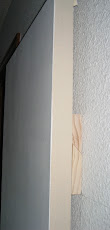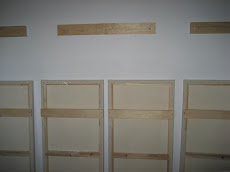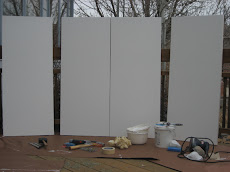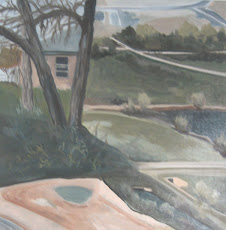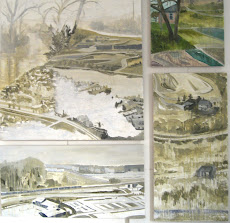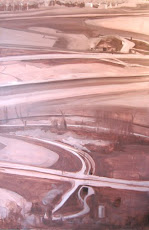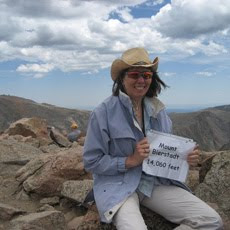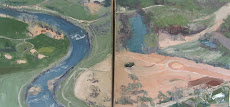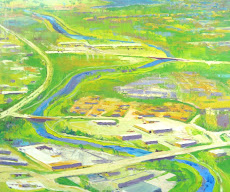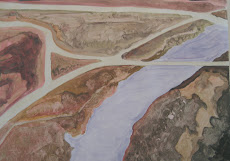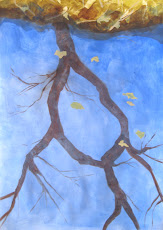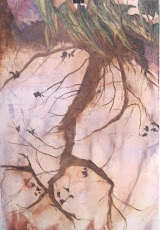Three of these paintings are still in the final stages of the underpainting in which I used a limited palette of black, white, yellow ochre, and burnt sienna. While experimenting with oil glazes on the 20x20 I learned that I need to tone down my transparent oil colors to get the effect that I am looking for. That painting has since been re-painted with the limited palette.
Friday, December 4, 2009
Last Homestead in process
My recent paintings are part of a series called Last Homestead. The title refers the home that remains in the center of construction along the bike path. Each painting shows either the house itself or the area around it from both aerial and ground level views. I am exploring ways to show the inevitable change that is now a significant part of our American lifestyle. There is tension between the disappearance of the familiar and the emergence of newer and better opportunities.
Sunday, November 1, 2009
Friday, October 23, 2009
Painting in Process
Encouraged to work larger, I am painting a 60 x 40" aerial view entitled Beyond the Bikepath.
I painted the monochromatic underpainting with acrylics. Now that I have blocked in the colors I think that the freshness of the underpainting is more successful than the colored version. I'm going to experiement with a limited palette and perhaps change the colors again once I have done these experiments.
I painted the monochromatic underpainting with acrylics. Now that I have blocked in the colors I think that the freshness of the underpainting is more successful than the colored version. I'm going to experiement with a limited palette and perhaps change the colors again once I have done these experiments.
Saturday, October 10, 2009
Disjunctive Space Workshop
I took a 2 day work shop with Melanie Authier this weekend. We discussed different types of space, and the effect of combining different or contrasting spaces in one painting. Our approach to the painting was through creating a collage with photographs and paper.
I asked Melanie about "contemporary landscape". She encouraged me to look at Dil Hildebrand whose paintings reflect his background in set design. She commented that contemporary landscape now often includes the influence of the urban environment.
Other artists she recommended are: Gary Evans, noting his process, which involves making sketches from his car and Monica Tap whose recent work involves the use of technology. Monica's series "One Second Hudson "depicts blurred images painted from a "quick time" video.
I asked Melanie about "contemporary landscape". She encouraged me to look at Dil Hildebrand whose paintings reflect his background in set design. She commented that contemporary landscape now often includes the influence of the urban environment.
Other artists she recommended are: Gary Evans, noting his process, which involves making sketches from his car and Monica Tap whose recent work involves the use of technology. Monica's series "One Second Hudson "depicts blurred images painted from a "quick time" video.
Friday, September 25, 2009
Multi panel paintings
I have been looking at multi panel paintings and have found that this format is popular with abstract artists who break one image into vertical bands, each segment painted on a separate panel.
The work of Trine Bumiller is also one continuous design, but her panels are different sizes, so the view of the image is determined by the arrangement of smaller canvases that together make one large composition. Her subject matter is often plants or trees. Don Eddy's work is in rectangles and squares, or alter-like pieces with a round edge at the top--sometimes arranged in vertical rows, and other times in pairs with a large vertical rectangle over a smaller vertical rectangle. His images are related by color or theme, but do not carry over into adjacent panels.
Bonnie Steinsnyder works in diptychs and triptychs as well as multi-paneled pieces, all of urban themes. Like Eddy, these each contain different but related images. Karen Kitchell often works in a series of 5 or more--often square panels all on the same horizontal plane. Her subject matter is plants or animal life that is not traditionally noticed or appreciated. Luis Gordillo's multi-paneled consists of vertical panels with related but not continuing design.
I plan to do a multi-panel piece that is related but not a continuing design. I am thinking about doing a triptych, but would like to keep the format flexible so that the panels could be hung in a row as one large rectangle, or in a balanced but non-symmetrical order.
The work of Trine Bumiller is also one continuous design, but her panels are different sizes, so the view of the image is determined by the arrangement of smaller canvases that together make one large composition. Her subject matter is often plants or trees. Don Eddy's work is in rectangles and squares, or alter-like pieces with a round edge at the top--sometimes arranged in vertical rows, and other times in pairs with a large vertical rectangle over a smaller vertical rectangle. His images are related by color or theme, but do not carry over into adjacent panels.
Bonnie Steinsnyder works in diptychs and triptychs as well as multi-paneled pieces, all of urban themes. Like Eddy, these each contain different but related images. Karen Kitchell often works in a series of 5 or more--often square panels all on the same horizontal plane. Her subject matter is plants or animal life that is not traditionally noticed or appreciated. Luis Gordillo's multi-paneled consists of vertical panels with related but not continuing design.
I plan to do a multi-panel piece that is related but not a continuing design. I am thinking about doing a triptych, but would like to keep the format flexible so that the panels could be hung in a row as one large rectangle, or in a balanced but non-symmetrical order.
Friday, September 11, 2009
Contemporary Painter
In looking at contemporary landscape painters, Sandy Litchfield exemplifies an artist who seems to enjoy nature as subject, but has developed a contemporary format for her work. Litchfield works on canvas, paper, and on the walls of galleries! Her work is very organic and includes painted collage-like areas of color and parts of images. The gallery website from her 2006 show describes her work as "map-like abstract paintings". I have thought of combining aerial and ground views, so I enjoy looking at how Sandy Litchfield solves this design problem. In describing her as contemporary, this article includes the following qualities: precise editing, a crisp approach to surface, broad array of technique, fresh, and suggestive.
Monday, August 31, 2009
Aerial Landscapes
My ideas about nature have been strongly influenced by spending time in the Rocky Mountains of Colorado. Hiking, horseback riding, and sking in the vastness of open land with no visible manmade structures surrounded by 14,000 foot mountains has given me an appreciation for the beauty and power of the natural world. It is common to see deer and other wildlife in these places.
Near my home, the urban environment offers designated open space to preserve trees and small animal life. There are concrete bike paths to access the river, and many people walk, jog, rollerblade, and cycle along these paths. I accept urban parks as a convenient substitute for the more authentic experiences of nature in the "high country" especially since I can still see the tall mountain peaks in the distance.
Reynolds Landing I and II reveals the attempts that have been made to make "nature" available to everyone by creating a park along the riverbank. On the other side of the river is a golf course--another man-made park. These areas allow us to feel that we are in nature, yet the concrete paths and proximity to major streets are indicators of a controlled urban environment.
Viewing these places from the air has increased my awareness of the artificiality of these environments. In Platte River Pathways I have intensified and enhanced the colors to emphasize the unnatural attempts to immitate nature in small areas sandwiched between the streets and the river. At the same time, there is evidence of the river's influence on the urban environment in that the paths, streets, and structures have been built around it.
Near my home, the urban environment offers designated open space to preserve trees and small animal life. There are concrete bike paths to access the river, and many people walk, jog, rollerblade, and cycle along these paths. I accept urban parks as a convenient substitute for the more authentic experiences of nature in the "high country" especially since I can still see the tall mountain peaks in the distance.
Reynolds Landing I and II reveals the attempts that have been made to make "nature" available to everyone by creating a park along the riverbank. On the other side of the river is a golf course--another man-made park. These areas allow us to feel that we are in nature, yet the concrete paths and proximity to major streets are indicators of a controlled urban environment.
Viewing these places from the air has increased my awareness of the artificiality of these environments. In Platte River Pathways I have intensified and enhanced the colors to emphasize the unnatural attempts to immitate nature in small areas sandwiched between the streets and the river. At the same time, there is evidence of the river's influence on the urban environment in that the paths, streets, and structures have been built around it.
Wednesday, July 1, 2009
What is a Contemporary Art Museum?
Looking at the purpose of contemporary art museums seems to help further define the word contemporary. These museums seem to imply that their definition of contemporary is the recent past--this past year vs the past 3 decades. This is a description of the Contemporary Art Museum of Houston:
"The Contemporary Arts Museum Houston is an idea and a place shaped by the present moment. The Museum exemplifies the dynamic relationship between contemporary art and contemporary society through its exhibitions, public and educational programs, and publications. The CAMH provides the physical and intellectual framework essential to the presentation, interpretation, and advancement of contemporary art; it is a vibrant forum for artists and all audiences, and for critical, scholarly, and public discourse.
The Contemporary Art Museum of St. Louis has a similar goal:
"As St. Louis’s forum for interpreting culture through contemporary visual art, we connect our visitors to the dynamic art and ideas of our times. As a gathering place for experiencing contemporary art and culture, we push the boundaries of innovation, creativity and expression."
"The Contemporary Arts Museum Houston is an idea and a place shaped by the present moment. The Museum exemplifies the dynamic relationship between contemporary art and contemporary society through its exhibitions, public and educational programs, and publications. The CAMH provides the physical and intellectual framework essential to the presentation, interpretation, and advancement of contemporary art; it is a vibrant forum for artists and all audiences, and for critical, scholarly, and public discourse.
The Contemporary Art Museum of St. Louis has a similar goal:
"As St. Louis’s forum for interpreting culture through contemporary visual art, we connect our visitors to the dynamic art and ideas of our times. As a gathering place for experiencing contemporary art and culture, we push the boundaries of innovation, creativity and expression."
What is Contemporary Art?
Contemporary art has been defined as "the art of our time". But who are WE and what is OUR TIME? One writer from About.com describes it as art since 1970. This description also includes the observation that contemporary art seems to be more "socially concious"and connected to issues such as feminism, globalization, or multiculturalism than art of previous generations.
What IS "Contemporary" landscape painting?
I've been looking at landscape shows hosted by art galleries within the past 5 years. Although many people like to use the word "contemporary" to describe their work, I have seen that there are varied opinions about what defines the contemporary landscape. Last fall, the Christinerose Gallery in Chelsea hosted a show entitled, From Above and Beyond: New Perspectives in Contemporary Landscape.
Monday, June 29, 2009
Painting and Photography
One possibility for my research this semester is the relationship between painting and photography. In an 2002 article from Frieze Magazine, the writer explains how artist Robert Bordo explores this idea in his work. In 2005 he had an exhibit at Alexander and Bonin in NYC.
The New York Times reviewed an earlier show at the same location. Another more recent 2008 piece from the New York Art Beat describes how Bordo's work "hovers between abstraction and landscape". This article from the Dec. 2004 Art Bulliton (from Jstore aerial photography as subject) includes valuable information about the history of photography related to painting.
The New York Times reviewed an earlier show at the same location. Another more recent 2008 piece from the New York Art Beat describes how Bordo's work "hovers between abstraction and landscape". This article from the Dec. 2004 Art Bulliton (from Jstore aerial photography as subject) includes valuable information about the history of photography related to painting.
Sunday, May 24, 2009
More ideas-nature as a reference
I have been exploring ways to integrate my interests in tree reflections, the relationship between man and nature, and the open space that has been preserved in my urban environment.
I am still trying to understand the meaning of the falling figures. Since I have been thinking about how to do more intuitive work, I started tearing old watercolor paintings and these are the images that resulted from that experiment. They could be a way of discussing the ideas of freedom from the urban lifestyle that often requires accumulation of stuff and in many cases leads to discontentment and stress. By letting go of the intense desire for material wealth people can be set free to appreciate the privileges of life in a free country.
Meanwhile I have continued to work on the tree reflections, this time with acrylic paint to eliminate the problem of the slow drying time of the oils. Although this practical choice has resulted in more paintings faster, I think the overall quality of the image is still better achieved with oil paint.
I literally gained new perspective on the landscape around my home by painting from photos I found on google earth, and others which I took from the air.
My mentor has encouraged me to use nature as a reference rather than a subject. This new work does refer to nature, but hopefully gives the viewer clues that there are ideas behind this work beyond literal representation.
I don't know where these explorations are taking me, but I have met my goals for this semester by going beyond the typical landscape painting. My last body of work now in progress involves using these images in a different method of mark-making -- monotype printing.
I am still trying to understand the meaning of the falling figures. Since I have been thinking about how to do more intuitive work, I started tearing old watercolor paintings and these are the images that resulted from that experiment. They could be a way of discussing the ideas of freedom from the urban lifestyle that often requires accumulation of stuff and in many cases leads to discontentment and stress. By letting go of the intense desire for material wealth people can be set free to appreciate the privileges of life in a free country.
Meanwhile I have continued to work on the tree reflections, this time with acrylic paint to eliminate the problem of the slow drying time of the oils. Although this practical choice has resulted in more paintings faster, I think the overall quality of the image is still better achieved with oil paint.
I literally gained new perspective on the landscape around my home by painting from photos I found on google earth, and others which I took from the air.
My mentor has encouraged me to use nature as a reference rather than a subject. This new work does refer to nature, but hopefully gives the viewer clues that there are ideas behind this work beyond literal representation.
I don't know where these explorations are taking me, but I have met my goals for this semester by going beyond the typical landscape painting. My last body of work now in progress involves using these images in a different method of mark-making -- monotype printing.
Wednesday, March 11, 2009
New Studio Work in process
I have started several different types of work:
1. Working with the idea of "escape" I have created figures out of a paper mache medium called clay crete. These are about 8" high.
2. I have also incorporated the escaping figure in 2 dimensional mixed media works with pastel over mono-type
3 Painting on gessoed paper: "Reaching" (40 x 32) and "Spring Fantasy" (18 x 24) depict reflections in water with the first layer dripped and poured on top of wet underpainting. Subsequent layers were added using liquin and transparent oil colors. These works incorporate the aspects of landscape that are most important to me--trees, sky, and water--in new ways
4. Urban Journey I (8x10) and Pedestrian Bridge I (18 x 24 ) are some new images that I am working with to explore the contrasts between the urban life and the unpopulated landscape, and transition from opposites such as darkness to light or ignorance to knowledge
1. Working with the idea of "escape" I have created figures out of a paper mache medium called clay crete. These are about 8" high.
2. I have also incorporated the escaping figure in 2 dimensional mixed media works with pastel over mono-type
3 Painting on gessoed paper: "Reaching" (40 x 32) and "Spring Fantasy" (18 x 24) depict reflections in water with the first layer dripped and poured on top of wet underpainting. Subsequent layers were added using liquin and transparent oil colors. These works incorporate the aspects of landscape that are most important to me--trees, sky, and water--in new ways
4. Urban Journey I (8x10) and Pedestrian Bridge I (18 x 24 ) are some new images that I am working with to explore the contrasts between the urban life and the unpopulated landscape, and transition from opposites such as darkness to light or ignorance to knowledge
Interview with Karen Gunderson
Karen Gunderson answers some important questions that relate to my research.
Visual Literacy
I came across this essay on An Artists Perspective on Visual Literacy by April Gornick as I was researching the "New Old Masters". She presented this information to the New York State Art Teachers Assosciation in 2004.
Thursday, February 12, 2009
Colorado Abstraction
Attended a panel discussion on the new book, Colorado Abstraction, at the Center for Visual Arts in Denver. Interesting to hear that Colorado has an extensive history of abstract painting.
The contemporary artists in the book are showing at the CVA and Robishon galleries, and the historical artists' work is currently in an exhibition at the Vance Kirkland Museum. One of the co-authors commented that she has observed that the openness of the Colorado landscape has inspired artists to go beyond the boundries of their representational painting. The vastness of the sky and land inspired artist,... to seek the perspective of the landscape from a parachute as he jumps from an airplane! Lorey Hobbs, my mentor, is also inspired by nature.
The contemporary artists in the book are showing at the CVA and Robishon galleries, and the historical artists' work is currently in an exhibition at the Vance Kirkland Museum. One of the co-authors commented that she has observed that the openness of the Colorado landscape has inspired artists to go beyond the boundries of their representational painting. The vastness of the sky and land inspired artist,... to seek the perspective of the landscape from a parachute as he jumps from an airplane! Lorey Hobbs, my mentor, is also inspired by nature.
Tuesday, February 10, 2009
Figurative Work
After another round of critiques at the January residency, I have been caught between moving on to new subject matter and defending my choice of landscape. I've been thinking about other subjects that address either the same themes as landscape painting, or opposing themes...I have realized that my attraction to landscape painting is to escape certain aspects of urban life. Does our society have an awareness of how the external influences of modern life have on the health of our interior? Constant negative media coverage of every event in the world, and the barrage of advertising lead to pervasive feelings of fear and discontentment. I believe that exposure to this chaos has a negative influence on the mind and soul. As a result, many Americans though living in a free country, are imprisoned by either anxiety or apathy. They have become disconnected from the natural world and have lost respect and appreciation for the mysteries that surround us. My next body of work will focus on oil paintings, monoprints and collage of figurative studies that depict the desire to escape, the searching for contentment, and the fearfulness that seems to dominate our culture. At the same time, I will be using pastels to paint very optimistic colorful images of the sky that provide a stark contrast to the figurative studies.
Subscribe to:
Posts (Atom)
